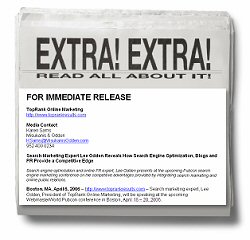
Press releases were originally designed as a communication tool between company PR staff or public relations firms and the media. But now that online news sites such as Yahoo News and Google News contain such an abundance of press release content and RSS makes it easy to syndicate news, press releases can be effectively used as a direct to consumer communication tool.
Not only are press releases an effective tool for distributing content to the media and consumers, they can easily be syndicated creating a excellent opportunity to attract incoming links. Some of the press releases our SEO firm optimizes and distributes have gained as few as 30 unique domain name links and some have garnered over 500 – all from a single press release.
Using progressive wire services like Business Wire, PR Newswire, PRWeb and Market Wire simplifies the process of getting news content into these popular news search engines.
To get an idea of how popular online news search is, comScore has reported that half of all internet users visit an online news site in a given month. Also, of all the online news sites including MSNBC, the New York Times, CNN, etc., Yahoo! News is the number one online news destination.
Realizing the opportunity news search offers, many company marketers continue to flounder at making sure their press releases receive maximum exposure. To that end, here are 10 tips for maximizing the visibility of press release content:
- Start with something worth announcing. Boring news gets little results no matter how well it’s optimized. It’s important to focus on a specific topic. Too much information and focusing on too many keywords will dilute the message for both news search engines and readers.
- Think upward and to the left. Optimize a press release using web page optimization principles and keep in mind that important keywords need to be near the top of the document with the most important keyword phrases first.
- Distribute the release via a wire service like Business Wire and PRWeb or PRNewswire. If you distribute the same release through more than one wire service on the same day, it is very likely that the news search engines will filter out the duplicates. If your story has more than one angle, take advantage of that and mix it up.
- Give the reader a reason to click through. A direct to consumer release needs to offer more than an announcement of news. It needs to provide the reader with an action opportunity. Examples include: white paper downloads, free trials, special offers, podcasts, webinars, reports, email newsletters and consultations.
- Create a landing page to convert referred press release visitors to prospects. You use landing pages with your PPC campaigns, don’t you? Then why not use them with your press release? Embed links in your release to relevant resources as welll as a strong call to action. Along with giving the reader a reason to click through, the destination of that link should be designed to bring the visitor further along the sales cycle for whatever the desired outcome is.
- Assemble a list of media contacts for the release and email them the release along with a concise, summary. Offer an exclusive if you can and suggesting story ideas that clearly indicate you’re familiar with the writer’s work can do wonders.
- Make it relevant and make it easy for journalists and bloggers to write about your news. Research bloggers that write about the topic and pre-write a summary of the release for them. In many cases, bloggers will simply copy/paste all or part of your summary and add their own commentary.
- Post the release to the company blog enabled media room. Ideally, the company site contains a blog that can archive press releases chronologically and by category, offers a search function, lists previous media exposure, contains links to media-centric photos, audio and video as well as an RSS feed to make it easy for interested parties, including journalists, to subscribe to company news.
- Write a blog post version of the news and submit to relevant social media sites. This does not work for all types of content and you need to be sure what you’re writing resonates with the culture of the social media networks that you want to promote to. Do not submit press releases directly to Digg, Netscape, Reddit, Stumble Upon, etc.
- Use social bookmark sites as a clipping service. Bookmark pickups of the release using social bookmark services such as del.icio.us, Furl.net or blogmarks.net. Such services can be linked to from the online media room and many become crawlable links for search engines.
As with any marketing effort, after the content is distributed, it’s important to track effectiveness. Tactics for tracking press release results include:
- Embed tracking codes in the links from the release to the landing page.
- Monitor the web analytics of the site the press release links to for referral traffic sources.
- Setup Google alerts to monitor when the release gets picked up.
- Monitor blog search engines like google blog search and technorati for pickups.
- Monitor standard search engines for pickups and links.
- Track conversions from press release landing pages.
For a more nostalgic look at press release optimization, take a look at this post from 2005, “Lowdown on Press Release Optimization“.


